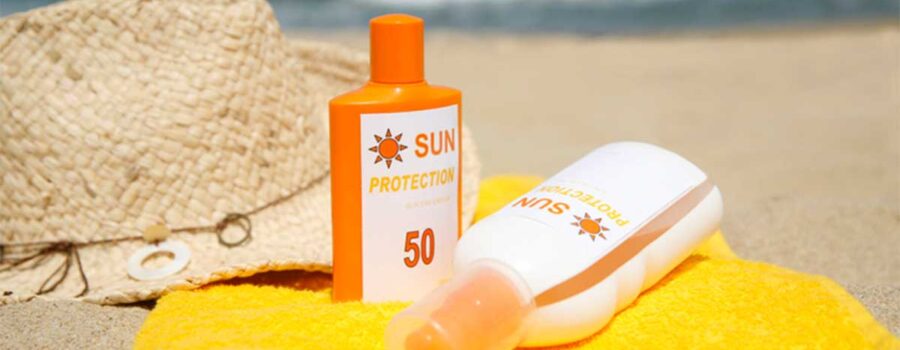As the summer months approach, many of us are looking forward to spending more time outdoors. Whether it’s hiking, swimming, or just soaking up the sun, it’s essential to remember the importance of protecting our skin from the harmful effects of UV radiation. Sunscreen is one of the most effective tools we have to protect our skin, but recent concerns about the safety of certain chemicals found in some sunscreens have raised questions about their use. It’s important to educate ourselves on the dangers of sunscreen and make informed decisions about which products we use to protect our skin.
Understanding UV Radiation and Sunscreen
The sun emits ultraviolet (UV) radiation, which is divided into three types: UVA, UVB, and UVC. UVC is absorbed by the Earth’s atmosphere and does not reach our skin, but both UVA and UVB rays can cause skin damage and increase the risk of skin cancer. Sunscreens work by absorbing, reflecting, or scattering these harmful rays to protect our skin from damage.
Chemical vs. Mineral Sunscreens
There are two primary types of sunscreen: chemical and mineral. Chemical sunscreens contain organic compounds that absorb UV radiation, while mineral sunscreens use inorganic compounds, like zinc oxide or titanium dioxide, to physically block or reflect UV rays. Chemical sunscreens have raised concerns about potential health risks due to the presence of certain toxins.
Toxic Ingredients in Chemical Sunscreens
Several ingredients commonly found in chemical sunscreens have been linked to potential health risks. But some of the most concerning toxic ingredients include:
Oxybenzone: A widely used UV filter in chemical sunscreens, oxybenzone has been found to cause skin irritation and allergies in some individuals. More alarmingly, research has shown that oxybenzone can be absorbed through the skin, leading to hormone disruption and potential harm to coral reefs when washed off in the ocean.
Octinoxate: Another common UV filter, octinoxate has been linked to hormone disruption, reproductive toxicity, and harm to marine life. Like oxybenzone, octinoxate is readily absorbed through the skin and has been detected in human blood, urine, and breast milk.
Homosalate: A UV filter that has been shown to disrupt estrogen, androgen, and progesterone hormones. This disruption can lead to developmental, reproductive, and metabolic issues, as well as concerns about the safety of long-term use.
Octocrylene: Another chemical sunscreen ingredient that has been associated with skin allergies and irritation. It can also produce free radicals when exposed to sunlight, which can cause oxidative stress and potential DNA damage.
Choosing Safer and More Effective Options
So, did you know that some sunscreens can be on the naughty list? Yep, you heard me right. Some sunscreens contain harmful chemicals that can do more harm than good. But don’t worry, there’s a nice list too!
Regulatory agencies have started to take action due to growing concerns about the safety of certain chemical sunscreen ingredients. As a result, in 2019, the US Food and Drug Administration (FDA) proposed a new rule to evaluate the safety and effectiveness of sunscreen ingredients. Specifically, out of the 16 active ingredients in sunscreens, the FDA recognized only zinc oxide and titanium dioxide (mineral sunscreens) as safe and effective. However, the safety of 12 other ingredients, including oxybenzone and octinoxate, remained uncertain.
Some places, like Hawaii, have even banned sunscreens containing oxybenzone and octinoxate due to their harmful impact on coral reefs. It’s important to be mindful of what we put on our skin and how it can affect our environment.
But don’t worry, there are plenty of safer alternatives to choose from. Consequently, mineral sunscreens use zinc oxide or titanium dioxide to physically block or reflect UV rays, offering a safer and more environmentally friendly option. Moreover, these ingredients are less likely to cause skin irritation and have not been linked to hormone disruption or environmental harm.
Tips for Choosing a Mineral Sunscreen and Using the Environmental Working Group Guide
When choosing a mineral sunscreen, make sure it provides broad-spectrum protection against both UVA and UVB rays. Also, since mineral sunscreens are often thicker than chemical sunscreens, it may take some time to find one that feels comfortable on your skin.
Additionally, if you’re feeling overwhelmed by all the options out there, don’t worry. The Environmental Working Group (EWG) releases an annual sunscreen guide that rates the safety and effectiveness of different sunscreens. It’s like having a personal sunscreen consultant!
The Naughty List
- Banana Boat Ultra Sport Sunscreen Lotion SPF 50
- Coppertone WaterBabies Sunscreen Lotion SPF 50
- Hawaiian Tropic Sheer Touch Sunscreen Lotion SPF 30
- Neutrogena Beach Defense Sunscreen Lotion SPF 70
- Neutrogena Ultra Sheer Dry-Touch Sunscreen Lotion SPF 55
- NO-AD Sun Care Sport Sunscreen Lotion SPF 50
- Ocean Potion Protect & Nourish Sunscreen Lotion SPF 30
- Sun Bum Original Sunscreen Lotion SPF 50
- Walgreens Sport Continuous Spray Sunscreen SPF 50
- Equate (Walmart) Ultra Protection Sunscreen Lotion SPF 50
The Good List
- Blue Lizard Australian Sunscreen
- Thinksport Safe Sunscreen
- Badger Unscented Sunscreen
- Sun Bum Mineral Sunscreen
- Babo Botanicals Clear Zinc Sunscreen
- Neutrogena Sheer Zinc Sunscreen
- Alba Botanica Sensitive Mineral Sunscreen
- La Roche-Posay Anthelios Mineral Sunscreen
- Goddess Garden Organics Mineral Sunscreen
- COOLA Mineral Sunscreen
Additional Sun Protection Measures
While using a safer sunscreen is one way to prevent over-exposure to the sun, there are many other ways to engage with smart sun exposure. Seeking shade, wearing protective clothing, being mindful of reflective surfaces, and checking the UV index are all important steps to take when spending time outdoors.
It’s important to remember that protecting your skin from the sun’s harmful rays is an essential aspect of maintaining overall health. Therefore, by choosing safer mineral sunscreens and practicing comprehensive sun protection measures, you can enjoy the outdoors without compromising your health or the environment. Additionally, you won’t have to worry about getting sunburned and becoming the butt of a dad joke at the next family barbecue.
References
- World Health Organization. “Ultraviolet Radiation (UV).” World Health Organization, 2021, https://www.who.int/uv/faq/whatisuv/en/index3.html.
- American Cancer Society. “How Do I Protect Myself from Ultraviolet (UV) Rays?” American Cancer Society, 2021, https://www.cancer.org/cancer/skin-cancer/prevention-and-early-detection/uv-protection.html.
- Gasparro, Francis P., et al. “Sunscreens, Skin Photobiology, and Skin Cancer: The Need for UVA Protection and Evaluation of Efficacy.” Environmental Health Perspectives, vol. 108, no. 1, 2000, pp. 71-78, doi: 10.1289/ehp.00108s171.
- Rodriguez, E., et al. “Skin Irritation and Sensitization to Sunscreen Agents.” Contact Dermatitis, vol. 50, no. 4, 2004, pp. 239-240, doi: 10.1111/j.0105-1873.2004.0363h.x.
- Downs, C. A., et al. “Toxicopathological Effects of the Sunscreen UV Filter, Oxybenzone (Benzophenone-3), on Coral Planulae and Cultured Primary Cells and Its Environmental Contamination in Hawaii and the U.S. Virgin Islands.” Archives of Environmental Contamination and Toxicology, vol. 70, no. 2, 2016, pp. 265-288, doi: 10.1007/s00244-015-0227-7.
- Krause, M., et al. “Sunscreen: Simultaneous Determination of Three UV Filters in Rat Plasma and in Human Plasma by High-Performance Liquid Chromatography-Tandem Mass Spectrometry.” Journal of Chromatography B, vol. 878, no. 28, 2010, pp. 2843-2848, doi: 10.1016/j.jchromb.2010.08.018.
- Janjua, N.R., et al. “Systemic Absorption of the Sunscreens Benzophenone-3, Octyl-Methoxycinnamate, and 3-(4-Methyl-Benzylidene) Camphor After Whole-Body Topical Application and Reproductive Hormone Levels in Humans.” Journal of Investigative Dermatology, vol. 123, no. 1, 2004, pp. 57-61, doi: 10.1111/j.0022-202X.2004.22725.x.
- Schmutzler, C., et al. “Endocrine Active Compounds Affect Thyrotropin and Thyroid Hormone Levels in Serum as well as TSH-, TRH-, and T-3-mRNA Expression in Rat Pituitary.” Toxicology Letters, vol. 111, no. 3, 2000, pp. 243-253, doi: 10.1016/S0378-4274(99)00250-1.
- Axelstad, M., et al. “Effects of Pre- and Postnatal Exposure to the UV-Filter Octyl Methoxycinnamate (OMC) on the Reproductive, Auditory, and Neurological Development of Rat Offspring.” Toxicology and Applied Pharmacology, vol. 250, no. 3, 2011, pp. 278-290, doi: 10.1016/j.taap.2010.11.005.
- Ghazipura, M., et al. “Exposure to Benzophenone-3 and Reproductive Toxicity: A Systematic Review of Human and Animal Studies.” Reproductive Toxicology, vol. 73, 2017, pp. 175-183, doi: 10.1016/j.reprotox.2017.08.015.
- Centers for Disease Control and Prevention. “The Burning Facts.” Centers for Disease Control and Prevention, 2014, https://www.epa.gov/sunsafety/burning-facts.
- Environmental Working Group. “EWG’s 2021 Guide to Sunscreens.” Environmental Working Group, 2021, https://www.ewg.org/sunscreen/report/executive-summary/.
- U.S. Food and Drug Administration. “Sunscreen Drug Products for Over-the-Counter Human Use; Proposed Amendment of Final Monograph.” Federal Register, vol. 84, no. 98, 2019, pp. 21472-21492, https://www.federalregister.gov/documents/2019/05/21/2019-10229/sunscreen-drug-products-for-over-the-counter-human-use-proposed-amendment-of-final-monograph.
- Liao, C., and Kannan, K. “Widespread Occurrence of Benzophenone-Type UV Light Filters in Personal Care Products from China and the United States: An Assessment of Human Exposure.” Environmental Science and Technology, vol. 47, no. 7, 2013, pp. 3343-3351, doi: 10.1021/es4002152.
- Environmental Working Group. “Mineral Sunscreens.” Environmental Working Group, 2021, https://www.ewg.org/sunscreen/report/mineral-sunscreens/.
- Pfotenhauer, K. M., and Shubrook, J. H. “Vitamin D Deficiency, Its Role in Health and Disease, and Current Supplementation Recommendations.” The Journal of the American Osteopathic Association, vol. 117, no. 5, 2017, pp. 301-305, doi: 10.7556/jaoa.2017.055.
- American Academy of Dermatology. “How to Select a Sunscreen.” American Academy of Dermatology, 2021, https://www.aad.org/public/everyday-care/sun-protection/sunscreen-patients/select-sunscreen.
- American Academy of Dermatology. “Sunscreen FAQs.” American Academy of Dermatology, 2021, https://www.aad.org/public/everyday-care/sun-protection/sunscreen-patients/sunscreen-faqs.








